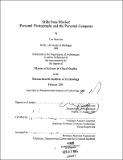| dc.contributor.advisor | Andrew Lippman. | en_US |
| dc.contributor.author | Hourvitz, Leo | en_US |
| dc.contributor.other | Massachusetts Institute of Technology. Dept. of Architecture. | en_US |
| dc.date.accessioned | 2012-11-19T19:06:03Z | |
| dc.date.available | 2012-11-19T19:06:03Z | |
| dc.date.copyright | 1984 | en_US |
| dc.date.issued | 1985 | en_US |
| dc.identifier.uri | http://hdl.handle.net/1721.1/74771 | |
| dc.description | Thesis (M.S.V.S.)--Massachusetts Institute of Technology, Dept. of Architecture, 1985. | en_US |
| dc.description | MICROFICHE COPY AVAILABLE IN ARCHIVES AND ROTCH. | en_US |
| dc.description | Includes bibliographical references (leaves 78-85). | en_US |
| dc.description.abstract | A system for the capture and combination of video images is proposed as a prototype for a future personal computer that allows free manipulation and intermixing of information from the computer, video, and photography domains. The benefits in power, flexibility, and applicability to each area from combining with the others are explored. The history and development of the three media contributing to the work is briefly examined, as are the techniques usable in moving between and combining them. The "Moviecliptool" system is described. Moviecliptool's purpose is to allow the generation of high quality stills from a recorded video sequence; that is, moving from the video to the photography domain via the computer. It allows the user to capture a sequence of frames from conventional video equipment into the computer. the frames are brought up on an interactive display where the user can select among them, view them in detail, and, more importantly, begin to combine them to his taste. Moviecliptool provides tools for image enhancements to try to alleviate the noise problems inherent in the video medium, as well as interactive tools for manipulating the content of the images, either by direct modification or by selective combination of the images. The environment supporting moviecliptool is extensively described, as it has helped shape the design of the system. Future developments and directions for similar systems are discussed. The appearance in the commercial world of relevant systems is seen as heralding a promising future for tools which transcend media boundaries. | en_US |
| dc.description.statementofresponsibility | by Leo Hourvitz. | en_US |
| dc.format.extent | 85 leaves | en_US |
| dc.language.iso | eng | en_US |
| dc.publisher | Massachusetts Institute of Technology | en_US |
| dc.rights | M.I.T. theses are protected by
copyright. They may be viewed from this source for any purpose, but
reproduction or distribution in any format is prohibited without written
permission. See provided URL for inquiries about permission. | en_US |
| dc.rights.uri | http://dspace.mit.edu/handle/1721.1/7582 | en_US |
| dc.subject | Architecture. | en_US |
| dc.title | Stills from movies : personal photography and the personal computer | en_US |
| dc.title.alternative | Personal photography and the personal computer | en_US |
| dc.type | Thesis | en_US |
| dc.description.degree | M.S.V.S. | en_US |
| dc.contributor.department | Massachusetts Institute of Technology. Department of Architecture | |
| dc.identifier.oclc | 13765233 | en_US |
